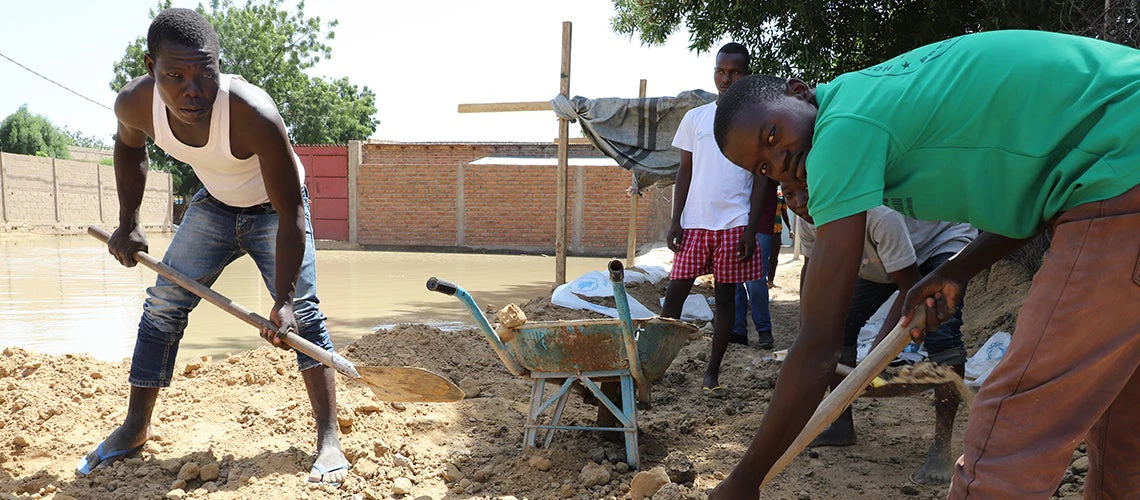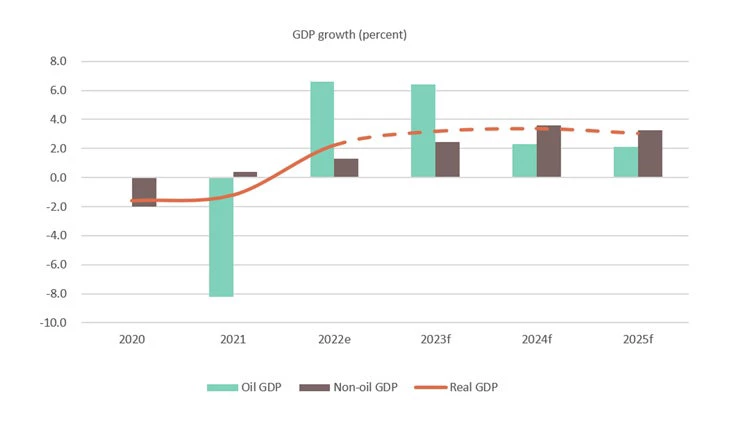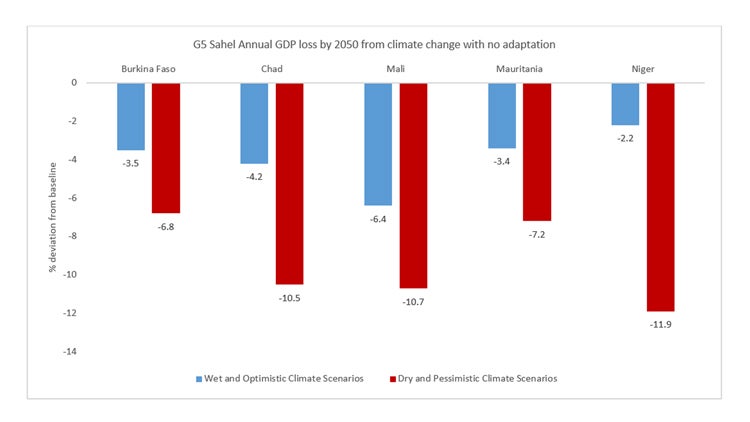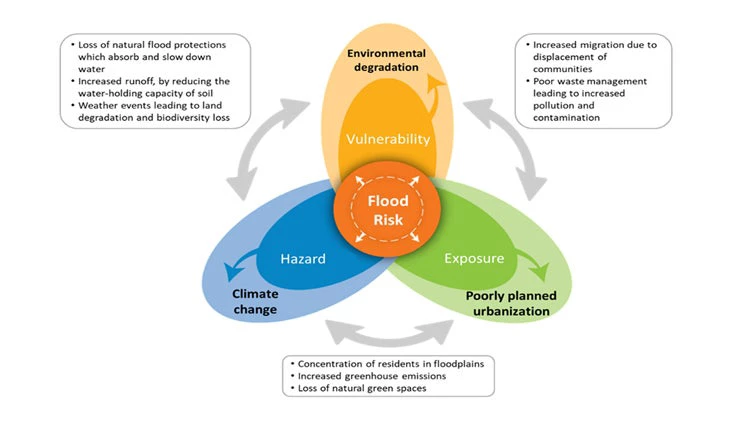 Young men cleaning up after the floods
Young men cleaning up after the floods
Chad’s GDP growth was modest due to the impact of floods and a volatile security environment, which hindered the expected recovery. After experiencing a contraction of 1.2 % contraction in 2021 (equivalent to a per capita contraction of 4.3 %), Chad’s economy was anticipated to bounce back in 2022 due to high global oil prices and increased oil production. The depreciation of the CFA franc against the US dollar was also expected to contribute to the recovery. However, the recovery was mitigated by floods and volatile security, resulting in an estimated GDP growth rate of 2.2 % (a per capita growth rate of -0.9). The non-oil GDP growth rate improved from 0.4 % in 2021 to 1.3% in 2022.
Figure 1. GDP grew in 2022 due to high oil revenues

The main driver of growth was the industry sector, mainly oil, which contributed 4.1 percentage points, followed by agriculture with a contribution of 0.6 percentage points due to inadequate rainfall distribution and severe floods.
Chad experienced unprecedented pluvial and fluvial floods in 2022, affecting 1.3 million people (7.3 % of the population) in 19 out of 23 provinces. This led to serious damages and highlighted the high level of floods risk in the country. Meanwhile, the domestic security and political situation remained tense, and the completion of the national dialogue in October 2022 marked the beginning of a second-phase transition.
The high revenue from the oil sector resulted in a fiscal surplus of 4.5 % of GDP in 2022, while the non-oil fiscal deficit was at 7.4 %. This positive trend was driven by the high oil revenue in 2021, as there is a one-year lag in tax collection, and lower capital expenditure in 2022 (a decrease of 17.7 %). The oil sector had an overall strong performance in 2022, accounting for 62.2% of total revenue, including grants and 86% of export value. By the end of 2022, the total public debt was estimated to have decreased to 49.6 % of GDP. Although the G20 Common Framework for Chad’s debt restructuring was successfully completed, the debt service-to-revenue ratio is projected to average 17% in 2022-23, before gradually declining to below 14% from 2024 onward.
The high food inflation in Chad resulted in increased poverty, particularly in rural areas. The poverty rate measured at the international extreme poverty line of $2.15/day (per capita, 2017 PPP) is estimated to have risen by 2.4 percentage points between 2021 and 2022. In 2022, poverty incidence reached 38.7%, implying that the number of extreme poor increased by over 600,000 people to reach 6.8 million. Extreme poverty in Chad is primarily concentrated in rural areas, where 47.4 % of the population is extremely poor, highlighting significant regional disparities. Food inflation played a significant role in exacerbating poverty with an inflation rate of 12.2 % in 2022, compared to 5.1 % in 2021.
Chad, as part of the Sahel region1, ranks among the world’s most vulnerable countries to climate change while having one of the highest poverty rates. According to the International Panel on Climate Change (IPCC), temperatures in the Sahel will rise by at least 2°C between 2021 and 2040, while rainfall patterns are projected to become more irregular. Without urgent investments in climate adaptation, the Sahel countries could experience a reduction of 7 to 12 percent of annual GDP by 2050, leading to an additional 13.5 million people living in poverty. Chad’s annual GDP could be reduced by 10.5 % by 2050, exacerbating poverty, particularly in rural areas and vulnerable border communities.
Figure 2. Chad could lose between 4.2 and 10.5 percent of GDP by 2050

The combination of unplanned and rapid urbanization, environmental degradation, and climate change amplifies the risks of floods in Chad. Urban centers such N’Djamena exhibit the highest exposure of built-up areas at 14 and 74% exposed to 1-in-10 and 1-in-100-year floods, respectively. Inadequate stormwater drainage and flood management infrastructure, often clogged by improper waste disposal, increase the likelihood and impacts of flash floods. The uncontrolled expansion of settlements and substandard construction practices further contribute to heightened flood risks in urban areas. As climate change brings more frequent and intense rainfall events, the ability of urban centers to benefit from urbanization becomes limited. To mitigate the escalating flood risks associated with urban growth, well-planned urbanization is critical.
Figure 3. Three main dynamics driving flood risk in Chad

The recent floods in Chad have been deadly, displacing populations, and inflicting severe damage to assets and infrastructure.
Targeted policy reforms can strengthen Chad’s ability to adapt and minimize the impacts of floods. This entails implementing comprehensive policies that target the three main drivers of floods. Firstly, measures to reduce vulnerability and increase the resilience of populations and assets to floods are required to mitigate the economic consequences, while fostering more productive cities. Secondly, addressing environmental degradation and minimizing its impacts will play a role in mitigating the compounding effects of risk factors. Finally, strengthening emergency preparedness and response capacity will be critical to minimize the adverse impacts and disruptions caused by floods.
1 The Sahel countries include Burkina Faso, Chad, Mali, Mauritania, and Niger



Join the Conversation